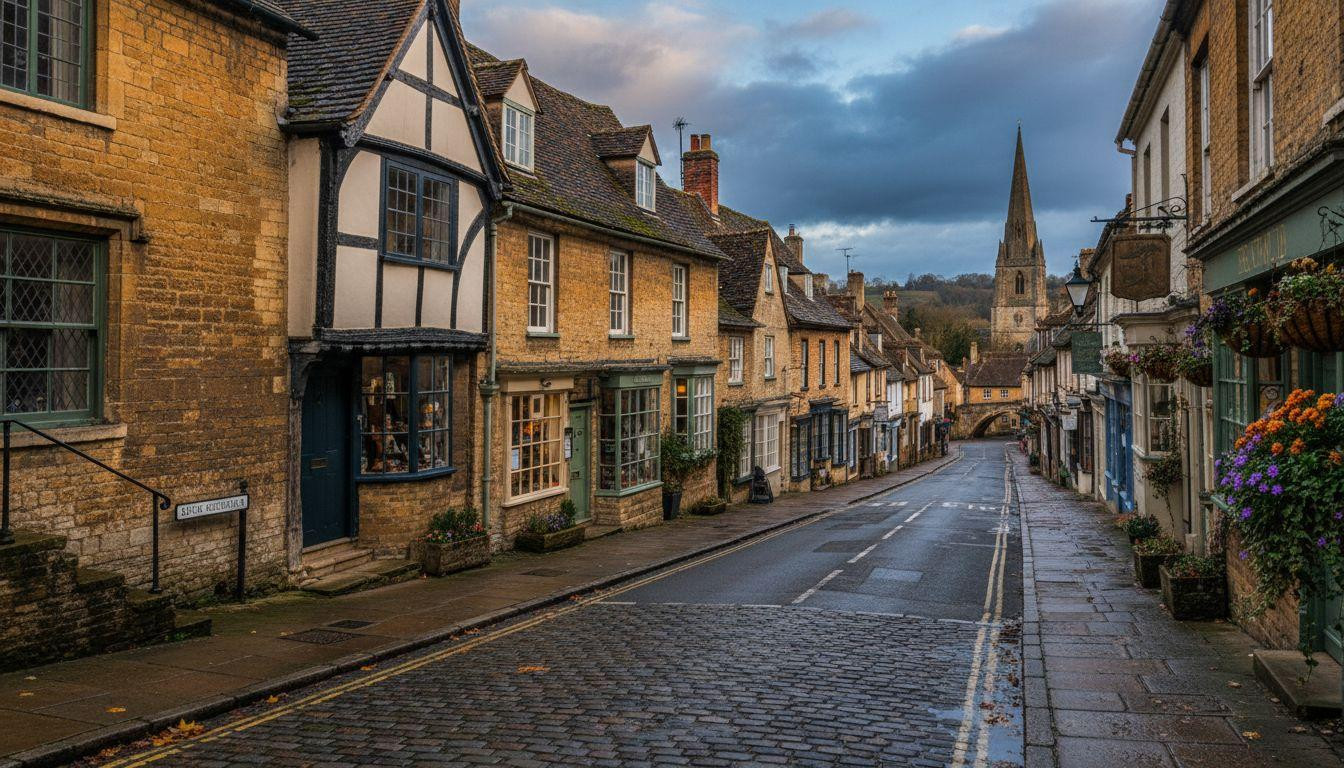While tour buses queue at Bibury’s Arlington Row by 9 AM and Bourton-on-the-Water charges $12 just to enter its Model Village, the Cotswolds’ most photographed villages have become victims of their own Instagram fame. Meanwhile, 20 miles east, golden November light catches Burford’s High Street as 1,500 residents begin their daily routines. This is the Cotswolds’ forgotten market town where medieval wool merchants built a living legacy, not a museum. Better than the touristy honey pots, Burford delivers authentic Cotswold charm with working antique shops, historic pubs pouring local ales, and accommodation for 50% less.
Why Bibury and Bourton-on-the-Water lost their soul
Bibury’s Arlington Row: 2.7 million Instagram posts, zero residents who can afford to live there anymore. Bourton-on-the-Water: Model Village, Birdland Park, Dragonfly Maze totaling $42 in entrance fees before lunch.
The numbers tell the story. Bibury accommodation averages $160-360/night in 2025. Bourton-on-the-Water parking costs $8-14/day in peak season. Combined annual visitors exceed 500,000 overwhelming villages designed for 500 residents.
What these villages do well: preserved medieval streetscapes, photogenic river crossings, manageable day-trip distances from London. What they’ve lost: the lived-in character that made them special in the first place.
Meet Burford where 1,500 residents still call the Cotswolds home
The landscape that built a wool empire
Burford’s High Street descends 300 vertical feet from St John the Baptist Church to the River Windrush’s three-arched medieval bridge. This isn’t accidental topography. It’s the geography that made Burford England’s richest wool market town from the 12th-17th centuries.
Golden Cotswold limestone glows against November skies while red tile roofs and flower-filled window boxes create visual contrast every Cotswolds village promises. The difference: you’re watching real life, not a living museum. Antique dealers unlock shops at 9 AM while children walk to Warwick Hall Primary School past 16th-century Tudor facades.
The price comparison that changes everything
Mid-range B&Bs cost $120-180/night in Burford versus $210-300 in Bibury. Pub lunches average $14-22 versus $22-30 in tourist villages. Parking remains free on High Street while Bourton charges $8-14/day.
Annual visitors total 150,000 in Burford versus Bibury’s estimated 250,000+, spread across a larger town footprint with actual infrastructure including banks, post office, and medical center. Similar medieval bridge towns across Europe offer comparable authentic experiences without overcrowding.
What you’ll experience in Burford
Medieval heritage that’s still functioning
The 12th-century St John the Baptist Church isn’t just a photo opportunity. It’s an active parish where Sunday services echo through wool-merchant-funded stone vaults. Inside: the 1569 memorial to Henry VIII’s barber-surgeon featuring one of Britain’s earliest depictions of Native Americans.
Walk 0.7 miles down High Street and you’ve traveled through 800 years of English architecture: Tudor timber frames, Georgian townhouses, Victorian shop fronts. The Tolsey Museum (free-$6 donation) occupies a 16th-century merchants’ meeting house where you’ll find Burford’s industrial past without gift shop pressure.
Gastropubs that source from Cotswold farms
The Golden Cotswold (reopened summer 2025) emphasizes seasonal ingredients: local lamb, Double Gloucester cheese, vegetables from Oxfordshire farms. Average meal costs $18-26 with beer from nearby Hook Norton brewery at $5.40/pint.
November bonus: log fires, fewer tourists, and mushroom foraging season means autumn menus feature wild porcini and chanterelles from nearby Wychwood Forest. Multiple local pubs claim Burford invented the Scotch egg. True or apocryphal, you’ll find excellent versions here. Other European villages with artisan food traditions share this dedication to local sourcing.
Planning your Burford visit
Train connections from London Paddington to Oxford run every 20 minutes (55 minutes, $34-50 standard class). Oxford to Burford takes 20 minutes by taxi ($24-30) or 30 minutes by bus X30 ($5.40). Direct coach service from London costs $18-30 for the 2.5-hour journey.
November offers ideal conditions: temperatures between 36-50°F, 60% fewer crowds than summer peaks, and accommodation rates 30% lower than July-August. Daylight lasts 8 hours (sunrise 7:15 AM, sunset 4:30 PM) perfect for exploring without overwhelming heat or crowds.
Daily budget totals $190-300 including accommodation, meals, and activities versus Bibury’s $300-420 range. Other UK heritage towns offer similar value propositions for authentic experiences.
Your questions about Burford England answered
How do I get to Burford from London without a car?
Take the train from London Paddington to Oxford (every 20 minutes, $34-50). From Oxford station, catch bus X30 to Burford (30 minutes, $5.40) or take a taxi (20 minutes, $24-30). Total journey time: 2-3 hours depending on connections.
What makes Burford more authentic than other Cotswolds villages?
Burford maintains a 65% ratio of local services to tourist shops on High Street. It has an active primary school, medical center, and year-round residents who work locally. Unlike Bibury where most properties are second homes, Burford functions as a living community first, tourist destination second.
Is Burford worth visiting in November weather?
November offers Burford’s sweet spot: 60% fewer crowds, cozy pub atmospheres with log fires, and seasonal menus featuring local game and foraged mushrooms. Accommodation costs drop 30% while maintaining full access to historical sites and restaurants. Similar authentic alternatives to famous destinations benefit from shoulder season visits.
By 4:30 PM, tour buses evacuate Bibury’s day-trippers back to London. In Burford, locals settle into The Lamb Inn’s 15th-century bar as November darkness wraps around honey-stone walls. This is what the Cotswolds looked like before Instagram transformed villages into open-air museums.
